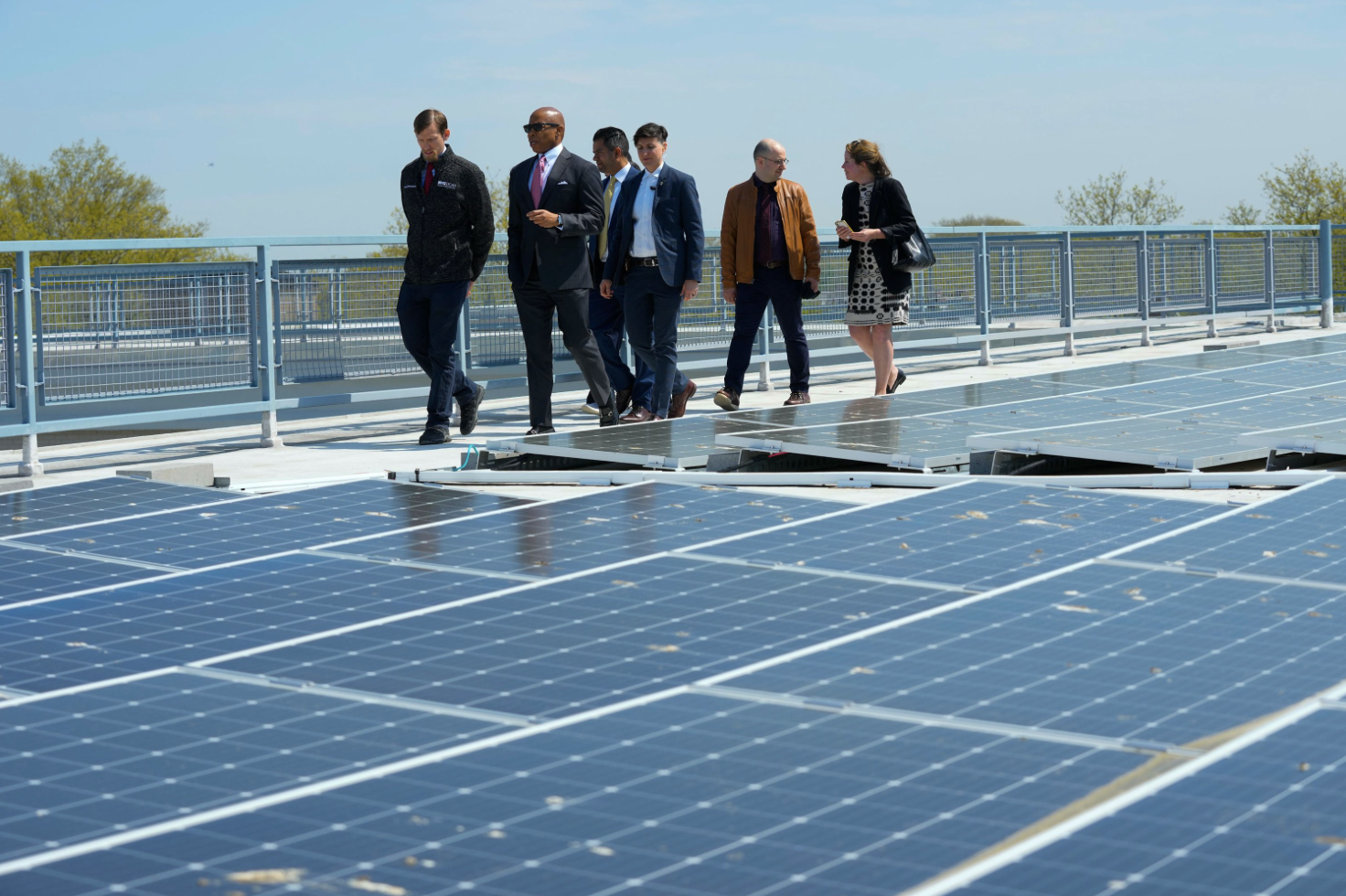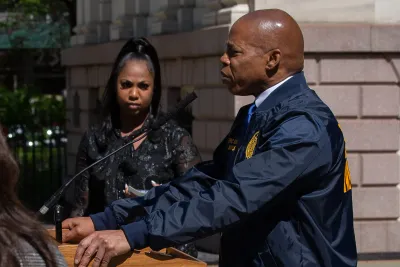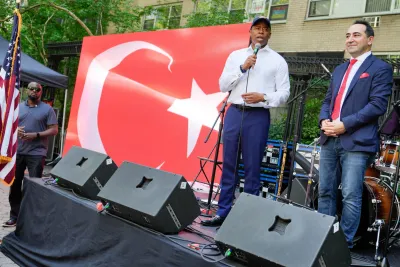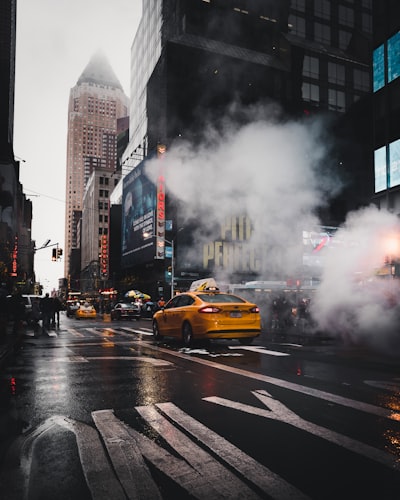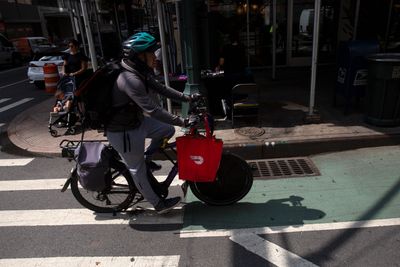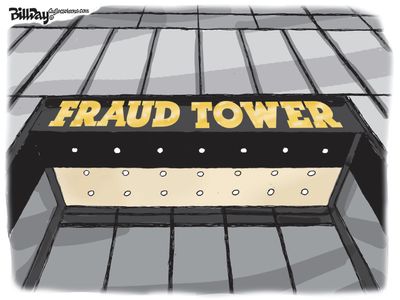Samantha Maldonado, The City

This article was originally published on Apr 20 7:49pm EDT by THE CITY
Buyouts for flood-prone properties. Solar arrays installed on homes — for free. Plentiful electric car chargers throughout the city. Freight deliveries by bike and boat instead of on-road trucks.
These are among the sustainability initiatives the Adams administration on Thursday put forth in its wide-ranging citywide agenda — known as PlaNYC — which aims to create jobs, fight climate change and make the five boroughs a cleaner and healthier place to live.
“It’s about equity and environmental justice, reducing air pollution and preventing flooding no matter where you live. We’ve seen what climate chaos can do to our city,” said Mayor Eric Adams, standing on the solar-paneled roof of Frank J. Macchiarola Educational Complex in Sheepshead Bay, Brooklyn.
He referred to the plan as “Get Sustainability Done,” saying, “It will jumpstart the era of transformative change and economic growth.”
The Bloomberg administration released the first PlaNYC in 2007, which set out to slash greenhouse gases and accommodate a growing population.
The de Blasio administration subsequently produced OneNYC, which had a broader scope and addressed more economic and social challenges. It envisioned a New York City that by 2050 would rely on renewable energy, with fewer cars, good jobs and secure housing for all.
Adams’ first PlaNYC follows his efforts to expand food waste recycling citywide and cut emissions associated with food purchases by expanding plant-based offerings. In alignment with the state climate law, Adams’ agenda aims to run the city on electricity that doesn’t emit planet-warming gases — instead relying on sources like solar, wind and hydropower — by 2040, and to slash emissions from transportation, buildings and waste a decade after that.
But the administration says it is focused on improving quality of life issues sooner than that.
“It’s so important to plan about those targets in the future, but it’s really about the here and now,” said Kizzy Charles-Guzman, executive director of the Mayor’s Office of Climate and Environmental Justice. “Making sure that New Yorkers know that we got them — the goal is to keep them safe and alive and enjoying their neighborhoods on their streets.”
What’s in the Plan
As part of the new plan, the Department of Environmental Protection will spearhead coastal resiliency efforts, including a program known as Climate Strong Communities.
The program aims to develop resiliency projects in areas that still lack protection plans even after Superstorm Sandy devastated the city’s coastal neighborhoods, killed at least 43 people and caused $19 billion worth of damage.
Climate Strong will start this year with initial collaborations with local communities in Soundview, Corona, Brownsville and Port Richmond. Additionally, the plan commits the city to accelerating existing resiliency efforts in East Harlem and Canarsie.
As part of these efforts, homeowners in areas that get repeatedly flooded could opt to take a buyout and relocate under a new program. The city would acquire the land and return it to nature. After Sandy, the city and state funded similar programs, but they didn’t take shape until months later, which experts say limited the impact.
/cdn.vox-cdn.com/uploads/chorus_asset/file/24599174/042023_planyc_adams_1.jpg)
The city doesn’t plan to identify eligible neighborhoods at this step, but will initially focus on standing up the bones of a program.
“Before you decide, here’s where I want to make offers, you have to set up an infrastructure to counsel people to make sure that they aren’t doing it in a vacuum, that they can find their alternatives when they make that decision,” said DEP Commissioner and Chief Climate Officer Rohit Aggarwala.
After Hurricane Ida in September 2021, several homeowners in flood-prone blocks in Queens asked the city for buyouts, but no program had been in place to make possible relocation a reality.
“It makes sense to be prepared to be able to assist residents in finding the safe harbor and at the same time avoid having to do multiple rebuilds,” said Eric Goldstein, New York City environment director for the nonprofit Natural Resources Defense Council. “If programs for relocating homeowners subject to repeated flooding are to be available, they need to be the day after, not months later.”
Other new PlanNYC initiatives include a program to install solar panels on 3,000 one-family and small multi-family properties owned by low-income homeowners using public financing. The city also proposed to install 1,000 curbside electric vehicle charging stations by 2025, with a broader goal of having every New Yorker access a fast charger within 2.5 miles by 2035.
In an effort to tackle the proliferating and highly polluting freight industry — partly a result of the booming demand for e-commerce — the administration also wants to move freight to waterways, rather than on roads, and expand cargo bike usage.
By 2027, the administration wants to pilot the east coast’s first “low-emissions zone” in a neighborhood experiencing heavy pollution from industrial traffic. Communities such as Red Hook that have seen an influx of e-commerce facilities in their neighborhoods have pushed for this idea, which has been implemented in Southern California, home to one of the largest concentrations of warehouses — and accompanying exhaust-spewing trucks — in the nation, as THE CITY previously reported.
Other goals include setting a maximum indoor temperature allowed so as to protect New Yorkers from extreme heat by 2030 — something Dallas has done. By 2060, PlanNYC hopes to eliminate raw sewage entering water bodies as a result of the sewer system being overwhelmed by moderate rainfall — in part by capturing more stormwater before it enters the system.
Where’s the Money?
More immediately, the Office of Management and Budget will work with agencies to determine whether their budget requests align with the city’s overall sustainability goals — though it remains to be seen whether the goals fit into agency budgets.
In order to fully implement the plans laid out in the agenda, the city is reliant on federal and state dollars — including through the $4.2 billion environmental bond voters approved and the Inflation Reduction Act the president signed last year.
“I’m excited that the city continues to come up with great ideas and hope we have the budget and staffing to meet the ambition,” said Amy Chester, director of resiliency firm Rebuild by Design.
Realizing PlaNYC’s ambitious goals may also prove difficult given the high rates of vacancies in city agencies and budget cuts on deck for the next four years. Adams, however, said the administration will still accomplish the goals “even with the restraints that are in front of us.”
Missing from the plan was any mention of using Rikers Island as a site for a green-energy hub — as laid out in the Renewable Rikers Act, which envisions a transformation of the island upon the jail complex’s mandated 2027 closure. The fate of Rikers under the Adams administration is up in the air.
“It’s a disappointment that Renewable Rikers was not included,” said Goldstein of the Natural Resources Defense Council. “The potential to create a modern wastewater treatment plant, solar and energy storage, and expand composting on the island offers a once-in-a-generation opportunity to address the city’s longstanding sustainability challenges.”
To facilitate the achievement of certain efforts, the Department of City Planning is working on a City of Yes for Carbon Neutrality zoning initiative. This would set regulations to make it easier to site battery storage systems, solar panels and vehicle chargers, among other provisions.
Next week, DCP will present the proposal to the City Planning Commission and launch a public review period.
Between the zoning updates and PlanNYC, “we are taking action to ensure New York City remains a global sustainability leader,” DCP Director Dan Garodnick said.
The City Council, too, is looking to play a role in furthering the sustainability agenda through policy — such as passing a law that could require air conditioning in newly constructed buildings, as PlaNYC also suggests.
“My job is to work with [the administration] to figure out not only how to get it done, but to figure out which initiatives need to be crystallized into law, so that they have to get done because something that is a goal, and a plan is different than a mandate that’s in a law,” said Councilmember James Gennaro, chair of the environmental protection, resiliency and waterfronts committee.
His committee next week will hold an oversight hearing on PlaNYC to kick off its next steps.
THE CITY is an independent, nonprofit news outlet dedicated to hard-hitting reporting that serves the people of New York.
